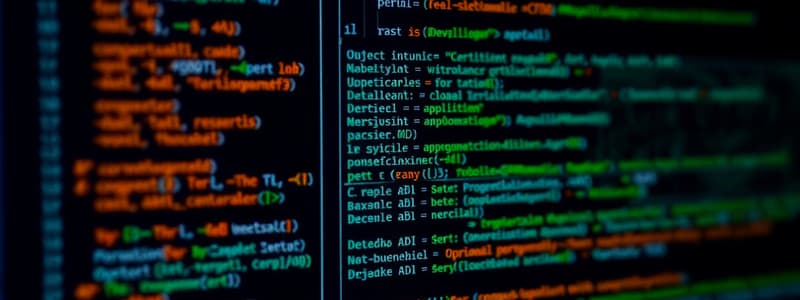Podcast
Questions and Answers
Which individual pointed out a missing semi-colon?
Which individual pointed out a missing semi-colon?
- Will McGinnis
- Kuang He
- Frank Hecker
- Swarup Sahoo (correct)
Who spotted that a variable named input shadows a built-in function?
Who spotted that a variable named input shadows a built-in function?
- Animesh B
- Victor Simeone (correct)
- Daniel Neilson
- Stephen Gregory
What kind of error did Martin Caspersen find?
What kind of error did Martin Caspersen find?
- Round-off errors (correct)
- Typographical error
- Missing documentation
- Syntax error
Which contributor suggested a clarification for an exercise?
Which contributor suggested a clarification for an exercise?
Who is known for correcting an error about the order of operations?
Who is known for correcting an error about the order of operations?
Which person translated the book into Italian and provided corrections?
Which person translated the book into Italian and provided corrections?
Who reported issues with links and changes in error messages?
Who reported issues with links and changes in error messages?
Which individual corrected a misstatement regarding Fermat’s last theorem?
Which individual corrected a misstatement regarding Fermat’s last theorem?
Which method is typically used to initialize an object in a class?
Which method is typically used to initialize an object in a class?
What is the primary advantage of using pure functions in programming?
What is the primary advantage of using pure functions in programming?
What concept allows an object to take on different forms or behaviors in object-oriented programming?
What concept allows an object to take on different forms or behaviors in object-oriented programming?
What is operator overloading primarily used for in a programming context?
What is operator overloading primarily used for in a programming context?
In object-oriented programming, what does 'debugging' primarily involve?
In object-oriented programming, what does 'debugging' primarily involve?
Which term describes the ability of a class to inherit properties and methods from another class?
Which term describes the ability of a class to inherit properties and methods from another class?
What is the primary purpose of the str method in a class?
What is the primary purpose of the str method in a class?
What is the significance of 'modifiers' in function definitions?
What is the significance of 'modifiers' in function definitions?
What is the primary skill emphasized for a computer scientist?
What is the primary skill emphasized for a computer scientist?
Which programming language is highlighted in this content as a high-level language?
Which programming language is highlighted in this content as a high-level language?
What is one disadvantage of high-level programming languages compared to low-level languages?
What is one disadvantage of high-level programming languages compared to low-level languages?
What does portability of high-level languages refer to?
What does portability of high-level languages refer to?
How do computer scientists use formal languages similar to mathematicians?
How do computer scientists use formal languages similar to mathematicians?
What aspect of programming is considered an excellent opportunity according to the content?
What aspect of programming is considered an excellent opportunity according to the content?
Which feature is NOT associated with high-level programming languages?
Which feature is NOT associated with high-level programming languages?
What does the content suggest about the relationship between programming and systems observation?
What does the content suggest about the relationship between programming and systems observation?
What is the primary characteristic of formal languages as compared to natural languages?
What is the primary characteristic of formal languages as compared to natural languages?
Which example best illustrates a syntactically correct mathematical statement?
Which example best illustrates a syntactically correct mathematical statement?
What is defined as a fundamental element of a language that includes words and numbers?
What is defined as a fundamental element of a language that includes words and numbers?
What would make the statement '3 + = 3' syntactically incorrect?
What would make the statement '3 + = 3' syntactically incorrect?
Which of the following statements correctly describes programming languages?
Which of the following statements correctly describes programming languages?
What would be an example of an invalid token in programming languages?
What would be an example of an invalid token in programming languages?
What is the primary focus of the syntax rules in formal languages?
What is the primary focus of the syntax rules in formal languages?
Which type of syntax rule concerns how tokens are structured within a statement?
Which type of syntax rule concerns how tokens are structured within a statement?
What is the primary focus of the advice given regarding interactions with computers?
What is the primary focus of the advice given regarding interactions with computers?
What is defined as the process of formulating a problem, finding a solution, and expressing the solution?
What is defined as the process of formulating a problem, finding a solution, and expressing the solution?
What does the term 'source code' refer to?
What does the term 'source code' refer to?
What is 'portability' in the context of programming?
What is 'portability' in the context of programming?
Which of these describes an executable file?
Which of these describes an executable file?
What is the main difference between 'interpret' and 'compile'?
What is the main difference between 'interpret' and 'compile'?
What best describes the term 'script' in programming?
What best describes the term 'script' in programming?
In programming, what is meant by 'interactive mode'?
In programming, what is meant by 'interactive mode'?
What is the primary difference between fruitful functions and void functions?
What is the primary difference between fruitful functions and void functions?
What happens if a fruitful function is called without storing or displaying its result in a script?
What happens if a fruitful function is called without storing or displaying its result in a script?
What type of error occurs when trying to access an undefined variable inside a function?
What type of error occurs when trying to access an undefined variable inside a function?
What does a traceback display when an error occurs during a function call?
What does a traceback display when an error occurs during a function call?
What is the special value returned when trying to capture the result of a void function?
What is the special value returned when trying to capture the result of a void function?
How can a script demonstrate the use of a fruitful function correctly?
How can a script demonstrate the use of a fruitful function correctly?
Which of the following statements is true regarding Python functions mentioned?
Which of the following statements is true regarding Python functions mentioned?
What indicates the current function running within a traceback?
What indicates the current function running within a traceback?
Flashcards
Decorator Pattern
Decorator Pattern
Design pattern that adds new functionality to existing objects dynamically without modifying their structure.
Python Programming Language
Python Programming Language
High-level, general-purpose programming language known for its readability and versatility.
Debugging
Debugging
Identifying and fixing errors in software or code.
Formal Language
Formal Language
Signup and view all the flashcards
Natural Language
Natural Language
Signup and view all the flashcards
Typo
Typo
Signup and view all the flashcards
Order of Operations
Order of Operations
Signup and view all the flashcards
Software Error
Software Error
Signup and view all the flashcards
High-level language
High-level language
Signup and view all the flashcards
Low-level language
Low-level language
Signup and view all the flashcards
Portability
Portability
Signup and view all the flashcards
Problem Solving
Problem Solving
Signup and view all the flashcards
Python
Python
Signup and view all the flashcards
Computer Scientist
Computer Scientist
Signup and view all the flashcards
Formal Language
Formal Language
Signup and view all the flashcards
Natural Language
Natural Language
Signup and view all the flashcards
Programming Language
Programming Language
Signup and view all the flashcards
Syntax
Syntax
Signup and view all the flashcards
Token
Token
Signup and view all the flashcards
Syntax Error
Syntax Error
Signup and view all the flashcards
Incremental Development
Incremental Development
Signup and view all the flashcards
Debugging
Debugging
Signup and view all the flashcards
Rectangles
Rectangles
Signup and view all the flashcards
Parameter vs Argument
Parameter vs Argument
Signup and view all the flashcards
Instances as return values
Instances as return values
Signup and view all the flashcards
Traceback
Traceback
Signup and view all the flashcards
Fruitful Function
Fruitful Function
Signup and view all the flashcards
Mutable Objects
Mutable Objects
Signup and view all the flashcards
Copying
Copying
Signup and view all the flashcards
Void Function
Void Function
Signup and view all the flashcards
None
None
Signup and view all the flashcards
Debugging
Debugging
Signup and view all the flashcards
Function Call Error
Function Call Error
Signup and view all the flashcards
Time
Time
Signup and view all the flashcards
Pure functions
Pure functions
Signup and view all the flashcards
Return Value
Return Value
Signup and view all the flashcards
Modifiers
Modifiers
Signup and view all the flashcards
Prototyping vs. Planning
Prototyping vs. Planning
Signup and view all the flashcards
Object-oriented features
Object-oriented features
Signup and view all the flashcards
Printing objects
Printing objects
Signup and view all the flashcards
Init method
Init method
Signup and view all the flashcards
str method
str method
Signup and view all the flashcards
Operator Overloading
Operator Overloading
Signup and view all the flashcards
Type-based dispatch
Type-based dispatch
Signup and view all the flashcards
Polymorphism
Polymorphism
Signup and view all the flashcards
Interface and implementation
Interface and implementation
Signup and view all the flashcards
Inheritance
Inheritance
Signup and view all the flashcards
Class attributes
Class attributes
Signup and view all the flashcards
Comparing cards
Comparing cards
Signup and view all the flashcards
Problem Solving
Problem Solving
Signup and view all the flashcards
High-Level Language
High-Level Language
Signup and view all the flashcards
Low-Level Language
Low-Level Language
Signup and view all the flashcards
Portability
Portability
Signup and view all the flashcards
Interpret
Interpret
Signup and view all the flashcards
Compile
Compile
Signup and view all the flashcards
Source Code
Source Code
Signup and view all the flashcards
Object Code
Object Code
Signup and view all the flashcards
Executable
Executable
Signup and view all the flashcards
Prompt
Prompt
Signup and view all the flashcards
Script
Script
Signup and view all the flashcards
Interactive Mode
Interactive Mode
Signup and view all the flashcards
Script Mode
Script Mode
Signup and view all the flashcards
Study Notes
Think Python
- Book title: Think Python
- Subtitle: How to Think Like a Computer Scientist
- Version: 2.0.17
- Author: Allen Downey
- Publisher: Green Tea Press
- Location: Needham, Massachusetts
Preface
- Book started in 1999 to teach a Java introductory programming class effectively
- Initial versions were too high level/detail, not enough high-level guidance on how to program.
- The author wrote the book to address the following:
- Keep the book short
- Minimize jargon: defining each term upon first use
- Gradual introduction of topics
- Focus on programming concepts and techniques, rather than specifics of a programming language
Contributor List
- Many readers provided corrections and suggestions over the years.
- Feedback can be sent to [email protected] for corrections or suggestions—page and section numbers will help.
Studying That Suits You
Use AI to generate personalized quizzes and flashcards to suit your learning preferences.




